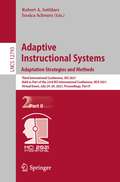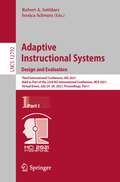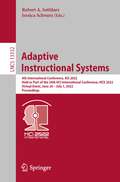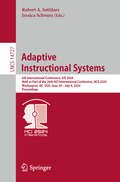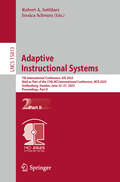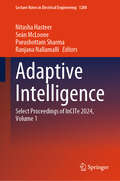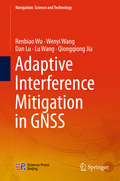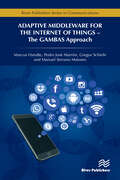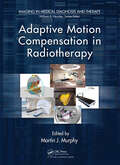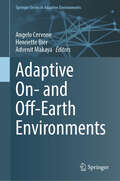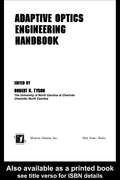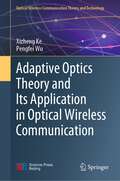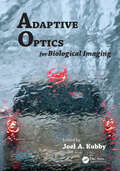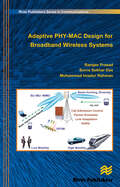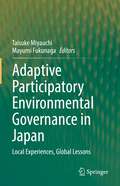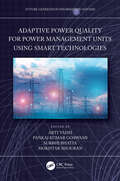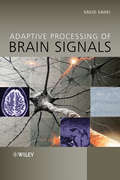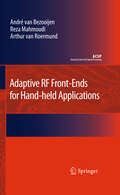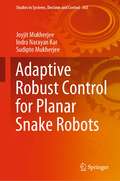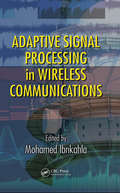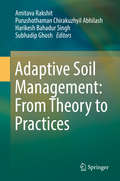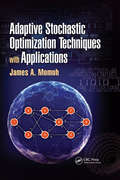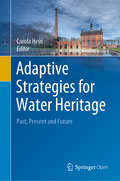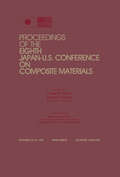- Table View
- List View
Adaptive Instructional Systems. Adaptation Strategies and Methods: Third International Conference, AIS 2021, Held as Part of the 23rd HCI International Conference, HCII 2021, Virtual Event, July 24–29, 2021, Proceedings, Part II (Lecture Notes in Computer Science #12793)
by Jessica Schwarz Robert A. SottilareThis two-volume set LNCS 12774 and 12775 constitutes the refereed proceedings of the 12th International Conference on Social Computing and Social Media, SCSM 2021, held as part of the 23rd International Conference, HCI International 2021, which took place in July 2021. Due to COVID-19 pandemic the conference was held virtually. The total of 1276 papers and 241 poster papers included in the 39 HCII 2021 proceedings volumes was carefully reviewed and selected from 5222 submissions. The regular papers of AIS 2021, Part II, focus on Learner Modelling and State Assessment in AIS.
Adaptive Instructional Systems. Design and Evaluation: Third International Conference, AIS 2021, Held as Part of the 23rd HCI International Conference, HCII 2021, Virtual Event, July 24–29, 2021, Proceedings, Part I (Lecture Notes in Computer Science #12792)
by Jessica Schwarz Robert A. SottilareThis two-volume set LNCS 12792 and 12793 constitutes the refereed proceedings of the Third International Conference on Adaptive Instructional Systems, AIS 2021, held as Part of the 23rd International Conference, HCI International 2021, which took place in July 2021. Due to COVID-19 pandemic the conference was held virtually.The total of 1276 papers and 241 poster papers included in the 39 HCII 2021 proceedings volumes was carefully reviewed and selected from 5222 submissions. The regular papers of AIS 2021, Part I, are organized in topical sections named: Conceptual Models and Instructional Approaches for AIS; Designing and Developing AIS; Evaluation of AIS; Adaptation Strategies and Methods in AIS.
Adaptive Instructional Systems: 4th International Conference, AIS 2022, Held as Part of the 24th HCI International Conference, HCII 2022, Virtual Event, June 26 – July 1, 2022, Proceedings (Lecture Notes in Computer Science #13332)
by Jessica Schwarz Robert A. SottilareThis book constitutes the refereed proceedings of the 4th International Conference on Adaptive Instructional Systems, AIS 2022, held as part of the 23rd International Conference, HCI International 2022, which was held virtually in June/July 2022.The total of 1271 papers and 275 posters included in the HCII 2022 proceedings was carefully reviewed and selected from 5487 submissions. The AIS 2022 proceedings were organized in the following topical sections: Learner Modeling and State Assessment for Adaptive Instructional Decisions; Adaptation Design to Individual Learners and Teams; Design and Development of Adaptive Instructional Systems; Evaluating the Effectiveness of Adaptive Instructional Systems.
Adaptive Instructional Systems: 6th International Conference, AIS 2024, Held as Part of the 26th HCI International Conference, HCII 2024, Washington, DC, USA, June 29–July 4, 2024, Proceedings (Lecture Notes in Computer Science #14727)
by Jessica Schwarz Robert A. SottilareThis book constitutes the refereed proceedings of 6th International Conference on Adaptive Instructional Systems, AIS 2024, held as part of the 26th International Conference, HCI International 2024, which took place in Washington, DC, USA, during June 29-July 4, 2024. The total of 1271 papers and 309 posters included in the HCII 2024 proceedings was carefully reviewed and selected from 5108 submissions. The HCII-AIS 2024 contributions have been organized in the following topical sections: Designing and developing adaptive instructional systems; adaptive learning experiences; AI in adaptive learning.
Adaptive Instructional Systems: 7th International Conference, AIS 2025, Held as Part of the 27th HCI International Conference, HCII 2025, Gothenburg, Sweden, June 22–27, 2025, Proceedings, Part I (Lecture Notes in Computer Science #15812)
by Jessica Schwarz Robert A. SottilareThe two-volume set LNCS 15812-15813 constitutes the thoroughly refereed proceedings of the 7th International Conference on Adaptive Instructional Systems, AIS 2025, held as part of the 27th HCI International Conference on Human-Computer Interaction, HCII 2025, which took place in Gothenburg, Sweden, in June 2025. The total of 1430 papers and 355 posters included in the HCII 2025 proceedings was carefully reviewed and selected from 7972 submissions. The two volumes cover topics as follows: Part I: Adaptive Training and Education; Cognitive Modeling of Adaptive Instructional Systems; Part II: Adaptive and Personalized Learning; Emerging Technologies in Adaptive Instruction.
Adaptive Instructional Systems: 7th International Conference, AIS 2025, Held as Part of the 27th HCI International Conference, HCII 2025, Gothenburg, Sweden, June 22–27, 2025, Proceedings, Part II (Lecture Notes in Computer Science #15813)
by Jessica Schwarz Robert A. SottilareThe two-volume set LNCS 15812-15813 constitutes the thoroughly refereed proceedings of the 7th International Conference on Adaptive Instructional Systems, AIS 2025, held as part of the 27th HCI International Conference on Human-Computer Interaction, HCII 2025, which took place in Gothenburg, Sweden, in June 2025. The total of 1430 papers and 355 posters included in the HCII 2025 proceedings was carefully reviewed and selected from 7972 submissions. The two volumes cover topics as follows: Part I: Adaptive Training and Education; Cognitive Modeling of Adaptive Instructional Systems; Part II: Adaptive and Personalized Learning; Emerging Technologies in Adaptive Instruction.
Adaptive Intelligence: Select Proceedings of InCITe 2024, Volume 1 (Lecture Notes in Electrical Engineering #1280)
by Seán McLoone Nitasha Hasteer Purushottam Sharma Ranjana NallamalliThis book comprises the select peer-reviewed proceedings of the 4th International Conference on Information Technology (InCITe-2024). It aims to provide a comprehensive knowledge base encompassing state-of-the-art research and development in adaptive intelligence, decision intelligence, artificial intelligence, deep learning, machine learning, data science, and enabling technologies for IoT, blockchain, and other futuristic technologies. It covers various topics that span cutting-edge, collaborative technologies and areas of computation. The content would serve as a rich knowledge repository on information & communication technologies, neural networks, fuzzy systems, natural language processing, data mining & warehousing, big data analytics, cloud computing, social networks, and intelligence, decision-making, and modeling, information systems, IT architectures, and security related aspects. This book provides a valuable resource for those in academia and industry.
Adaptive Interference Mitigation in GNSS (Navigation: Science and Technology)
by Lu Wang Renbiao Wu Wenyi Wang Dan Lu Qiongqiong JiaThis book introduces readers to adaptive interference mitigation techniques based on multiple antennas for global navigation satellite systems (GNSS) in the time, domain, spatial and spatial-temporal domains. As the performance of GNSS can easily be impacted by various intentional and unintentional interferences, the book explores in detail various types of interference, including jamming , high dynamic jamming, spoofing, multipath and pulsed interference. It offers a valuable reference work for graduate students and engineers in the field of satellite navigation and signal processing.
Adaptive Middleware for the Internet of Things: The GAMBAS Approach
by Pedro José Marrón Gregor Schiele Marcus Handte Matoses Manuel SerranoOver the past years, a considerable amount of effort has been devoted, both in industry and academia, towards the development of basic technology as well as innovative applications for the Internet of Things. Adaptive Middleware for the Internet of Things introduces a scalable, interoperable and privacy-preserving approach to realize IoT applications and discusses abstractions and mechanisms at the middleware level that simplify the realization of services that can adapt autonomously to the behavior of their users. Technical topics discussed in the book include:Behavior-driven Autonomous ServicesGAMBAS Middleware ArchitectureGeneric and Efficient Data AcquisitionInteroperable and Scalable Data ProcessingAutomated Privacy PreservationAdaptive Middleware for the Internet of Things summarizes the results of the GAMBAS research project funded by the European Commission under Framework Programme 7. It provides an in-depth description of the middleware system developed by the project consortium. In addition, the book describes several innovative mobility and monitoring applications that have been built, deployed and operated to evaluate the middleware under realistic conditions with a large number of users. Adaptive Middleware for the Internet of Things is ideal for personnel in the computer and communication industries as well as academic staff and research students in computer science interested in the development of systems and applications for the Internet of Things.
Adaptive Motion Compensation in Radiotherapy (Imaging in Medical Diagnosis and Therapy)
by Martin J. MurphyExternal-beam radiotherapy has long been challenged by the simple fact that patients can (and do) move during the delivery of radiation. Recent advances in imaging and beam delivery technologies have made the solution-adapting delivery to natural movement-a practical reality. Adaptive Motion Compensation in Radiotherapy provides the first detailed
Adaptive On- and Off-Earth Environments (Springer Series in Adaptive Environments)
by Henriette Bier Angelo Cervone Advenit MakayaThis volume investigates the challenges and opportunities for designing, manufacturing and operating off-Earth infrastructures in order to establish adaptive human habitats. The adaptive aspects are considered with respect to the development of adequate infrastructures designed to support human activities. Given the limitations in bringing materials from Earth, utilisation of in-situ resources is crucial for establishing and maintaining these infrastructures.Adaptive on-and off-Earth Environments focuses, among other aspects, on the design, production, and operation processes required to build and maintain such off-Earth infrastructures, while heavily relying on In-Situ Resource Utilisation (ISRU). Such design, production, and operation processes integrate cyber-physical approaches developed and tested on Earth. The challenge is to adapt on-Earth approaches to off-Earth applications aiming at technology advancement and ultimately transfer from on- to off-Earth research. Thischallenge is addressed with contributions from various disciplines ranging from power generation to architecture, construction, and materials engineering involving ISRU for manufacturing processes. All chapters, related to these disciplines, are structured with an emphasis on computing and adaptivity of on-Earth technology to off-Earth applications and vice versa to serve society at large.
Adaptive Optics Engineering Handbook
by Robert TysonThis handbook supplies analytical tools for the design and development of adaptive optics systems to enhance their ability to adjust for atmospheric turbulence, optical fabrication errors, thermally induced distortions, and laser device aberrations. It provides recommendations for selecting, testing and installing a wavefront compensation system.
Adaptive Optics Theory and Its Application in Optical Wireless Communication (Optical Wireless Communication Theory and Technology)
by Xizheng Ke Pengfei WuThis book introduces in detail the theory of adaptive optics and its correction technology for light wave distortion in wireless optical communication. It discusses the adaptive control algorithm of wavefront distortion, proportional+integral control algorithm and iterative control algorithm, and double fuzzy adaptive PID control algorithm. It also covers the SPGD algorithm of adaptive optics correction, deformable mirrors eigenmode method of wavefront aberration correction, vortex beam wavefront detecting wavefront aberration correction, liquid crystal spatial light modulator wavefront correction, different wavelengths of Gaussian beam transmission wavefront differences in the atmospheric turbulence and correction and with wavefront tilt correction adaptive optics wavefront aberration correction. Various distortion correction methods are verified by experiments and the experimental results are analyzed. This book is suitable for engineering and technical personnel engaged in wireless optical communication, college teachers, graduate students and senior undergraduate students.
Adaptive Optics for Biological Imaging
by Joel A. KubbyAdaptive Optics for Biological Imaging brings together groundbreaking research on the use of adaptive optics for biological imaging. The book builds on prior work in astronomy and vision science. Featuring contributions by leaders in this emerging field, it takes an interdisciplinary approach that makes the subject accessible to nonspecialists who
Adaptive PHY-MAC Design for Broadband Wireless Systems (River Publishers Series In Communications Ser.)
by Ramjee Prasad Suvra Sekhar Das Muhammad Imadur RahmanThe next generation mobile communication networks (4G) have the challenging target of The next generation mobile communication networks (4G) have the challenging target of providing a peak data rate of 1 Gigabit per second local area and 100 Megabit per second wide area. The ability to offer such high data rates in 100MHz bandwidth requires overall a very high spectral efficiency, and hence the need for multi-antenna techniques (MIMO) with spatial multiplexing, fast dynamic link adaptation and packet scheduling, wideband access techniques, and most likely non-contention based spectrum sharing among multiple operators. Many of these required technology components and techniques are well researched and established. Adaptive PHY-MAC Design for Broadband Wireless Systems explains how one can integrate and optimise their use in providing the target cell data rates with high availability. The authors address the ability to cope with interference and enhanced physical layer processing, and simultaneously, the multifaceted system level design. Focus is also on the selection of technology components and techniques, which leads to the highest spectral efficiency and peak data rate availability with reasonable Quality of Service (QoS) support, such as improved outage scenario, reduced delay, guaranteed bit rate, etc.In short, this book will answer questions such as, how individual techniques relate to each other, how can we benefit the gains by suitable combinations of different technologies and how to choose different technological solutions in different scenarios, etc.The next generation mobile communication networks (4G) have the challenging target of The next generation mobile communication networks (4G) have the challenging target of providing a peak data rate of 1 Gigabit per second local area and 100 Megabit per second wide area.
Adaptive Participatory Environmental Governance in Japan: Local Experiences, Global Lessons
by Taisuke Miyauchi Mayumi FukunagaThis book contributes to the theoretical and practitioner literature in environmental governance and sustainability of natural resources by linking case studies of the roles of narratives to the three key practices in local environmental governance: socio-political legitimacy in participation; collaboratively creating stakeholder-ness, and cultivating social and ecological capabilities. It provides numerous theoretical insights on legitimacy, adaptability, narratives, process-oriented collaborative planning, and among others, using in-depth case studies from historical and contemporary environmental issues including conservation, wildlife management, nuclear and tsunami disasters, and thus community risk, recovery, and resiliency. The authors are all practitioner-oriented scientists and scholars who are involved as local stakeholders in these practices. The chapters highlight their action and participatory-action research that adds deeper insights and analyses to successes, failures, and struggles in how narratives contribute to these three dimensions of effective environmental governance. It also shows how stakeholders’ kinds of expertise, in a historical context, help to bridge expert and citizen legitimacy, as well as spatial and jurisdictional governance structures across scales of socio-political governanceOf particular interest, both within Japan and beyond, the book shares with readers how to design and manage practical governance methods with narratives. The detailed design methods include co-imagination of historical and current SESs, designing processes for collaborative productions of knowledge and perceptions, legitimacy and stakeholder-ness, contextualization of contested experiences among actors, and the creation of evaluation standards of what is effective and effective local environmental governance.The case studies and their findings reflect particular local contexts in Japan, but our experiences of multiple natural disasters, high economic growth and development, pollutions, the nuclear power plant accident, and rapidly aging society provide shared contexts of realities and provisional insights to other societies, especially to Asian societies.
Adaptive Power Quality for Power Management Units using Smart Technologies (Future Generation Information Systems)
by Surbhi Bhatia Arti Vaish Pankaj Kumar Goswami Mokhtar ShouranThis book covers issues associated with smart systems due to the presence of onboard nonlinear components. It discusses the advanced architecture of smart systems for power management units. It explores issues of power management and identifies hazardous signals in the power management units of smart devices. It Presents adaptive artificial intelligence and machine learning-based control strategies. Discusses advanced simulations and data synthesis for various power management issues. Showcases solutions to the uncertainty and reliability issues in power management units. Identifies new power quality challenges in smart devices. Explains hybrid active power filters, shunt hybrid active power filters, and the industrial internet of things in power quality management. This book comprehensively discusses advancements of traditional electrical grids, the benefits of smart grids to customers and stakeholders, properties of smart grids, smart grid architecture, smart grid communication, and smart grid security. It further covers the architecture of advance power management units (PMU) of smart devices, and the identification of harmonic distortions with respect to various sensor-based technology. It will serve as an ideal reference text for senior undergraduate and graduate students, and academic researchers in fields including electrical engineering, electronics, communications engineering, and computer engineering.
Adaptive Processing of Brain Signals
by Saeid SaneiIn this book, the field of adaptive learning and processing is extended to arguably one of its most important contexts which is the understanding and analysis of brain signals. No attempt is made to comment on physiological aspects of brain activity; instead, signal processing methods are developed and used to assist clinical findings. Recent developments in detection, estimation and separation of diagnostic cues from different modality neuroimaging systems are discussed.These include constrained nonlinear signal processing techniques which incorporate sparsity, nonstationarity, multimodal data, and multiway techniques.Key features:Covers advanced and adaptive signal processing techniques for the processing of electroencephalography (EEG) and magneto-encephalography (MEG) signals, and their correlation to the corresponding functional magnetic resonance imaging (fMRI)Provides advanced tools for the detection, monitoring, separation, localising and understanding of functional, anatomical, and physiological abnormalities of the brainPuts a major emphasis on brain dynamics and how this can be evaluated for the assessment of brain activity in various states such as for brain-computer interfacing emotions and mental fatigue analysisFocuses on multimodal and multiway adaptive processing of brain signals, the new direction of brain signal research
Adaptive RF Front-Ends for Hand-held Applications (Analog Circuits and Signal Processing)
by Reza Mahmoudi Arthur H.M. van Roermund Andre Van BezooijenThe RF front-end - antenna combination is a vital part of a mobile phone because its performance is very relevant to the link quality between hand-set and cellular network base-stations. The RF front-end performance suffers from changes in operating environment, like hand-effects, that are often unpredictable. Adaptive RF Front-Ends for Hand-Held Applications presents an analysis on the impact of fluctuating environmental parameters. In order to overcome undesired behavior two different adaptive control methods are treated that make RF frond-ends more resilient: adaptive impedance control, and adaptive power control. Several adaptive impedance control techniques are discussed, using a priori knowledge on matching network properties, in order to simplify robust 2-dimensional control. A generic protection concept is presented, based on adaptive power control, which improves the ruggedness of a power amplifier or preserves its linearity under extremes. It comprises over-voltage, over-temperature, and under-voltage protection.
Adaptive Robust Control for Planar Snake Robots (Studies in Systems, Decision and Control #363)
by Indra Narayan Kar Joyjit Mukherjee Sudipto MukherjeeThis book shows how a conventional multi-layered approach can be used to control a snake robot on a desired path while moving on a flat surface. To achieve robustness to unknown variations in surface conditions, it explores various adaptive robust control methods.The authors propose a sliding-mode control approach designed to achieve robust maneuvering for bounded uncertainty with a known upper bound. The control is modified by addition of an adaptation law to alleviate the overestimation problem of the switching gain as well as to circumvent the requirement for knowledge regarding the bounds of uncertainty. The book works toward non-conservativeness, achieving efficient tracking in the presence of slowly varying uncertainties with a specially designed framework for time-delayed control. It shows readers how to extract superior performance from their snake robots with an approach that allows robustness toward bounded time-delayed estimation errors. The book also demonstrates how the multi-layered control framework can be simplified by employing differential flatness for such a system. Finally, the mathematical model of a snake robot moving inside a uniform channel using only side-wall contact is discussed. The model has further been employed to demonstrate adaptive robust control design for such a motion.Using numerous illustrations and tables, Adaptive Robust Control for Planar Snake Robots will interest researchers, practicing engineers and postgraduate students working in the field of robotics and control systems.
Adaptive Signal Processing in Wireless Communications
by Mohamed IbnkahlaAdaptive techniques play a key role in modern wireless communication systems. The concept of adaptation is emphasized in the Adaptation in Wireless Communications Series through a unified framework across all layers of the wireless protocol stack ranging from the physical layer to the application layer, and from cellular systems to next-generation wireless networks. This specific volume, Adaptive Signal Processing in Wireless Communications is devoted to adaptation in the physical layer. It gives an in-depth survey of adaptive signal processing techniques used in current and future generations of wireless communication systems. Featuring the work of leading international experts, it covers adaptive channel modeling, identification and equalization, adaptive modulation and coding, adaptive multiple-input-multiple-output (MIMO) systems, and cooperative diversity. It also addresses other important aspects of adaptation in wireless communications such as hardware implementation, reconfigurable processing, and cognitive radio. A second volume in the series, Adaptation and Cross-layer Design in Wireless Networks(cat no.46039) is devoted to adaptation in the data link, network, and application layers.
Adaptive Soil Management: From Theory to Practices
by Harikesh Bahadur Singh Amitava Rakshit Purushothaman Chirakuzhyil Abhilash Subhadip GhoshThe book focuses in detail on learning and adapting through partnerships between managers, scientists, and other stake#65533;holders who learn together how to create and maintain sustainable resource systems. As natural areas shrink and fragment, our ability to sustain economic growth and safeguard biological diversity and ecological integrity is increasingly being put to the test. In attempting to meet this unprecedented challenge, adaptive management is becoming a viable alternative for broader application. Adaptive management is an iterative decision-making process which is both operationally and conceptually simple and which incorporates users to acknowledge and account for uncertainty, and sustain an operating environment that promotes its reduction through careful planning, evaluation, and learning until the desired results are achieved. This multifaceted approach requires clearly defined management objectives to guide decisions about what actions to take, and explicit assumptions about expected outcomes to compare against actual outcomes. In this edited book, we address the issue by pursuing a holistic and systematic approach that utilizes natural resources to reap sustainable environmental, economic and social benefits for adap#65533;tive management, helping to ensure that relationships between land, water and plants are managed in ways that mimic nature.
Adaptive Stochastic Optimization Techniques with Applications
by James A. MomohAdaptive Stochastic Optimization Techniques with Applications provides a single, convenient source for state-of-the-art information on optimization techniques used to solve problems with adaptive, dynamic, and stochastic features. Presenting modern advances in static and dynamic optimization, decision analysis, intelligent systems, evolutionary pro
Adaptive Strategies for Water Heritage: Past, Present and Future
by Carola HeinThis Open Access book, building on research initiated by scholars from the Leiden-Delft-Erasmus Centre for Global Heritage and Development (CHGD) and ICOMOS Netherlands, presents multidisciplinary research that connects water to heritage. Through twenty-one chapters it explores landscapes, cities, engineering structures and buildings from around the world. It describes how people have actively shaped the course, form and function of water for human settlement and the development of civilizations, establishing socio-economic structures, policies and cultures; a rich world of narratives, laws and practices; and an extensive network of infrastructure, buildings and urban form. The book is organized in five thematic sections that link practices of the past to the design of the present and visions of the future: part I discusses drinking water management; part II addresses water use in agriculture; part III explores water management for land reclamation and defense; part IV examines river and coastal planning; and part V focuses on port cities and waterfront regeneration. Today, the many complex systems of the past are necessarily the basis for new systems that both preserve the past and manage water today: policy makers and designers can work together to recognize and build on the traditional knowledge and skills that old structure embody. This book argues that there is a need for a common agenda and an integrated policy that addresses the preservation, transformation and adaptive reuse of historic water-related structures. Throughout, it imagines how such efforts will help us develop sustainable futures for cities, landscapes and bodies of water.
Adaptive Structures, Eighth Japan/US Conference Proceedings
by Golam M. NewazFirst published in 1998. A collection of papers presented at the Proceedings of the Eighth Japan-U.S. Conference On Composite Materials, SEPTEMBER 24 to 25 , 1998. The conference is organized by Wayne State University and American Society for Composites in cooperation with U.S. Organizing Committee and the Japanese Organizing Committee. Since the Seventh Meeting in Kyoto in 1995, this meeting brings together accomplished composite researchers between the two countries to share latest developments and advances in the field. The scope of the current conference ranges over all aspects of composite materials with some emphasis on infrastructure applications of composites. Key areas in composites are covered by 110 papers with 35 presentations from Japan.
